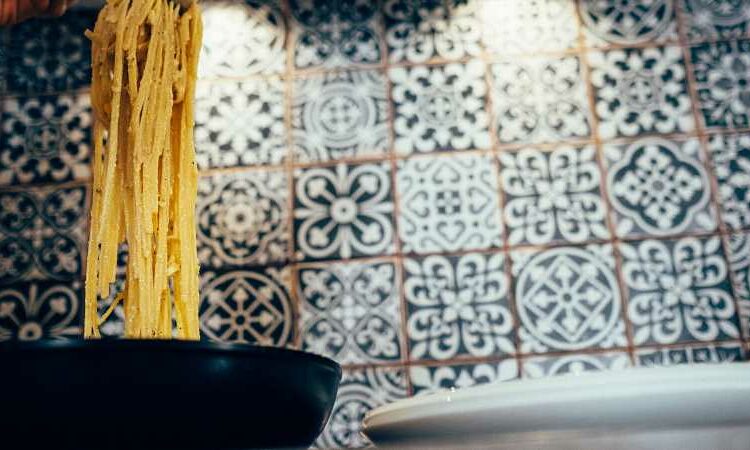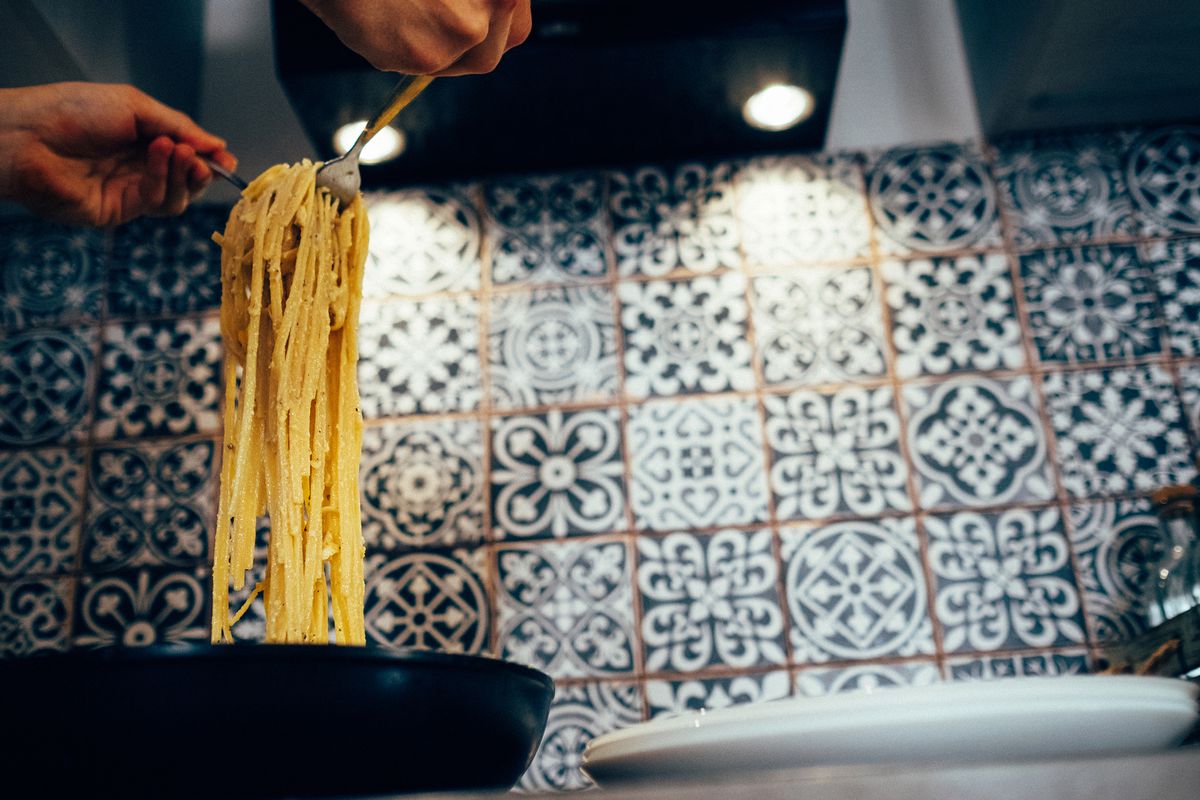If you want to learn how to make pasta, there are a million websites to scour, cookbooks to read, classes to take, and blogs to follow. But if you really want to know the secrets to pasta perfection, it helps to talk to a master.
Luckily, there's a very modest, yet extremely gregarious, master who was willing to divulge a thing or two about making pasta that might help you at home. That master is none other than Massimo Bottura, the three-Michelin-starred chef of the uber-famous Osteria Francescana in Modena, Italy.
A quick primer on Bottura in case you're one of the last handful of people on Earth who don't know about him: The Modena, Italy-born chef first became interested in cooking by watching his grandmother, mother, and aunt in the kitchen. Since opening his restaurant, Osteria Francescana, Bottura has not only earned three Michelin stars, but also the No. 1 spot on the World's 50 Best Restaurants list. Today, between opening restaurants around the globe, Bottura and his wife, Lara Gilmore, run a non-profit called Food for Soul that advocates for healthy and equitable food and helps feed thousands of people in need around the world. In addition, Bottura and Gilmore have started Tortellante: part lab, part school, part business that primarily helps kids and young adults with autism achieve active roles in society through making pasta.
We asked Bottura about making his own pasta and he divulged some of his secrets plus a few stories that will both make you hungry and warm your heart.
Martini & Rossi Fiero & Tonic doesn’t compromise when it comes to the right way to do things. Made with 100% natural flavors, using time-honored production methods, it is crafted specifically to be enjoyed amongst friends.
Travel + Leisure: How do you think about making pasta?
Massimo Bottura: "For me, making pasta is in my DNA. Especially since I was born in Emilia Romagna with a mother and a grandmother making pasta. Growing up in Modena, you could hear an eight-cylinder Maserati passing through, or a Ferrari with a 12-cylinder, and your ear can recognize if it's an eight or a turbo or a 12 cylinder. You have it in your DNA. But with pasta, it's a little different. Anyone can learn, but it's all about practice, practice, and more practice. It's natural for me at this point and it's something where on any occasion in any part of the world without even having the recipe or if I just get some flour, I know exactly how much it is and how much I need. But when you want to make a real pasta, you have to start from the basics."
Let's talk about those basics. What flour do you prefer to use when making pasta?
"We use Molino Borsari, that is double zero, and the production comes from old seeds that are organic and specific to Emilia Romagna. For the pasta, you take one kilo or about two pounds of flour and 10 eggs. And it's better if these eggs are fed with corn so the pasta comes out extremely yellow and you have a beautiful color and an amazing taste. For the tortellini and the tagliatelle, you use the whole egg.
These kinds of things are normal for us, but people don't realize that these suggestions are very important and can change the final results of your dough."
How do you think about mixing the dough?
"One thing that is extremely important, once you start mixing flour and eggs is to always keep your hands warm. With your hands clean and warm, you can mix the dough and transfer energy and heat to the dough. And the dough will answer you and will come out extremely smooth. But it's also about doing the right movement, almost like dancing and moving your hips, one and two and one and two. You keep mixing the dough until you see some bubbles on top and that means you did the right movement, and that the dough is almost ready."
How long do you let the dough rest once it reaches that perfect point with the bubbles?
"Half an hour is enough. It can rest for 30-40 minutes, but no more. And it needs to be covered, because otherwise it's going to crack when you roll it. You need to rest the dough because it's been stressed. It needs to relax. So, you cover it with plastic wrap or a moist towel. I still have the towel my mother gave to me and it's a mix of cotton and linen and very thin. At that point, when you start rolling out the dough with a mattarello, the dough reacts extremely well."
For rolling the dough, do you only use a mattarello or also a pasta machine?
"It depends. With tortellini you cannot use the machine. Once you cook them, the reaction in your palate is going to be too slippery. When you use the machine, it's not rough enough to help the pasta grip onto the sauce. It's almost like the difference between penne lisce (smooth penne) and penne rigate (lined penne). Italians always prefer the ones with the lines in it. It was actually funny during quarantine, the only pasta left on the shelves in the grocery store was penne lisce.
Sometimes, though, you can start with a machine, but you finish with the mattarello made with wood and roll it on a wood surface to make it more grippy."
When rolling, how thin do you want to go for tortellini vs. lasagna vs. tagliatelle, and so on?
"For the tortellini, they have to be extremely thin. Because tortellini are about the filling that you put inside. It's like a secret mixture of prosciutto, mortadella, parmigiano, and then some people put pork, and others put pork and chicken, and some other people do chicken and veal. You know, everyone has their own filling for the tortellini. And as I always say, ravioli and tortellini are containers. Containers of ideas. And with this kind of pasta, you can really express yourself. But you can also make it a surprise because you don't see what's inside. This is one of the most important things. And if it's the right thinness, it will melt into your palate and you will have the explosion from the filling on the inside.
Tagliatelle is different. Here's a little story about my mother and my family. Once they finished rolling the pasta, they would roll it just a little more with the mattarello and they would keep the window half open, which would help the light come through. And they would look at the sheets of pasta through the light and they would decide if it was perfectly done for tortellini or if it was a little irregular for tagliatelle. And if the pasta is irregular, you roll it, you cut it, and you create these noodles. The reaction is totally different, but the texture ends up matching perfectly with a hand-chopped Bolognese sauce.
And finally, for lasagna, it's completely different because it has to be thicker. You need to boil it in water with a touch of extra virgin olive oil and you need to keep a bowl of ice water on hand. So, you boil the pasta for just 30 seconds at most and then you put it in the ice water to stop the cooking process."
When you're making tortellini, how do you keep the consistency of each individual tortellini from the first to the hundredth?
"You keep part of the dough covered with plastic wrap while you're making the tortellini so the dough stays moist. Once all the tortellini are made, they're left on a drying rack. But it's not just to dry the pasta, it's to keep each one separated from each other and keep air circulating around them."
For cooking fresh pasta, how long do you cook for and do you salt the water?
"So, it depends. With tortellini it depends on whether you want to make it with a broth or with cream or with a parmigiano reggiano sauce. For the broth, you can cook the tortellini in the broth, but this is family style because at the end the broth is not super clear. Or, you cook in the broth and you keep a separate broth on the side. You then strain the tortellini, put it on your plate and then add the hot clear broth. Then you have the perfect tortellini en brodo.
If you cook them in water, you have to keep a little bit of broth on the side for the parmigiano reggiano sauce. I only salt the water a little bit because remember, tortellini are made with filling like mortadella or prosciutto, so it's already salty and rich and savory. At that point, you cook the tortellini, and in the moment they rise to the surface of the pot, you take them out and leave it in the broth that you kept aside. But just a touch of broth for them to absorb the flavor of the broth. Then you plate it, and you finish the tortellini with the creamy parmigiano reggiano sauce. So, it's in the middle between tortellini with broth and tortellini with cream. And then when you finish it with a 36-month parmigiano reggiano, they are the most amazing thing.
You know, when I was nine or 10 years old, I spent a whole month with my grandmother in the hills. Her brother had a cheese company and was making parmigiano. And I was asking my grandmother to make me tortellini alla panna every day. And she did, she made it for me every day. So now, at Maria Luisa we have a tasting menu, and we finish the menu with the Oops I Dropped the Lemon Tart. But then we surprise them, and we really close the dinner with the tortellini alla panna as my grandmother made for me. And people go crazy. It's the best grandma's recipe with heavy fresh cream and people cry. They get really emotional because it takes them back to their childhood."
Source: Read Full Article

